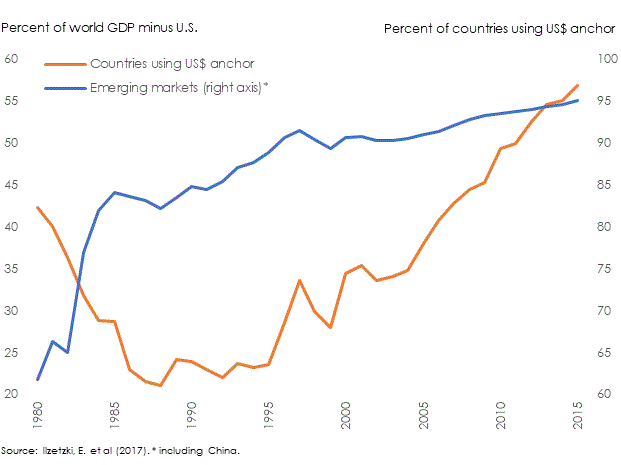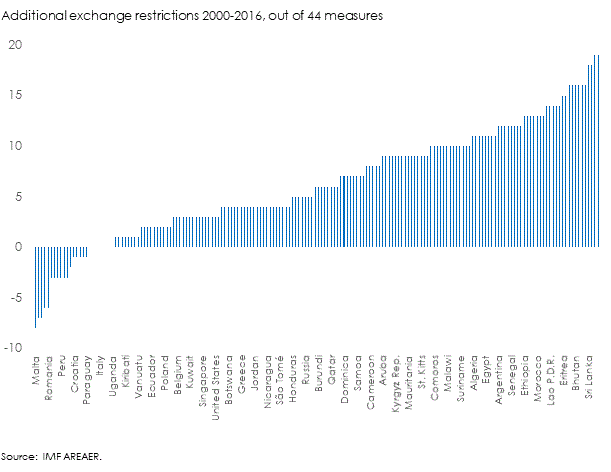Emerging markets vulnerability to exchange rate shocks—A curative approach
3 May 2018
The U.S. Federal Reserve announced on 2 May that it will keep its policy rate at its current level. The Fed reiterated that it sees economic conditions warranting "further gradual increases in the federal funds rate."1 Emerging markets currencies have notoriously been vulnerable to U.S. interest rate rises and in particular a stronger dollar. The prospect of a sustained rate increase therefore causes some disquiet or worse. Yet, it is important to be reminded that emerging markets exchange rate vulnerability seems largely "self-inflicted." A curative approach is needed.
Argentina's recent strong defense of its peso sounds familiar. The central bank has sold foreign exchange reserves and raised its policy rate to support a flagging currency. Emerging markets look vulnerable again as the dollar rises.
Emerging markets exchange rate vulnerabilities rest largely in their adopted exchange rate regimes. Apart from the obvious possible macroeconomic imbalances, inflation and external indebtedness, there are built-in destabilisers as most emerging markets tie their currencies closely to the dollar. A recent study based on observed exchange rate patterns affirms the importance of the dollar as anchor currency and shows that in 2015 120 countries representing almost 60 percent of world GDP use the dollar as currency anchor.2 Of the 120, excluding the U.S., almost all or 95 percent in terms of GDP are China and emerging markets.
Chart 1. Dollar anchor
The vulnerability is related to the so-called Triffin-dilemma. While the stability of emerging markets’ currencies will depend like most currencies on macroeconomic fundamentals, the fact of tying the currency to another currency naturally complicates economic policies when there is divergence between the economic needs of the anchor and anchored country. Complications also arise if countries use international reserve accumulation to stabilise the exchange rate against the anchor that will depend on the anchor country’s willingness to let its net reserve position deteriorate. Fluctuations in the supply of reserves by the anchor country could be destabilising and so could sustained differences in the supply and demand of reservable or safe assets.
Emerging markets’ actual and perceived vulnerabilities have increased. Emerging markets have taken a large number of measures to increase exchange restrictions in an attempt to guard against their exchange vulnerabilities. The IMF’s annual report on exchange arrangements and exchange restrictions shows measures that countries take to restrict free currency use for current and capital transactions. It indicates a rise between 2000 and 2016 from 12.5 measures out of 44 per country to 18.6 measures.3 94 percent of the restrictive measures were taken by emerging markets.
Chart 2. Exchange restrictions
The dollar was unquestionably the only game in town after World War II. Western European countries though pursued a policy of reducing dollar dependence vigorously through restoring currency convertibility. Actual convertibility for Germany, France, the United Kingdom and other Western European countries was only achieved towards the end of the 1950s. Meanwhile with the European Payments Union through the end of the 1950s, attempts were made to reduce the use of dollars to settle international transactions. While countries remained anchored to the dollar under the Bretton Woods System at least until 1973, Western European countries pursued early a pro-active policy of stabilising their exchange rates vis-à-vis one another.
The dollar’s ubiquity today is paradoxically largely due to emerging markets. Their faster economic growth, rapid international reserve accumulation in particular from 2000 and heavy reliance on the dollar has given the dollar a second international life fostering its dominance.
Emerging markets require an active policy to substitute the dollar as anchor. A palliative approach of seeking greater external support through expanding the global financial safety net is unlikely to be sufficient. Similarly, more exchange restrictions may induce unwanted distortions or be ineffective. A curative approach would consist of tackling the built-in vulnerabilities by establishing alternative exchange rate regimes. Currency independence is rarely achieved in isolation with the yen being a notable exception. Important currencies have had important support: The pound from the colonial sterling zone; the dollar from the Bretton Woods system; the mark from the European Monetary System. Some collaborative approach would help.
Emerging markets need to find a cure against exchange rate vulnerability. The dollar ought to be replaced with an anchor that may be closer to representing emerging markets’ own economic interests and performances. Emerging markets are far too heterogenous to be represented by a single anchor. Some more currency anchors are therefore to be found. While the renminbi could naturally become a key currency anchor it would have to wean itself off the dollar first.
1 Federal Reserve, press release, 2 May 2018.
2 Ilzetzki, E, Reinhart, C., Rogoff, K., Exchange arrangements entering the 21st century: Which anchor will hold?, mimeo, 29 September 2017.
3 IMF AREAER database.

